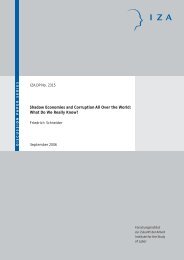The Great Recession of 2008-2009: Causes ... - Index of - IZA
The Great Recession of 2008-2009: Causes ... - Index of - IZA
The Great Recession of 2008-2009: Causes ... - Index of - IZA
- TAGS
- recession
- index
- ftp.iza.org
Create successful ePaper yourself
Turn your PDF publications into a flip-book with our unique Google optimized e-Paper software.
What then is the link between the global financial crisis and the imbalances leading up to<br />
2007? It is argued that the flows <strong>of</strong> capital from China and other exporting countries fed into<br />
the US housing bubble and credit boom along with its depressing effect on bond yields. For<br />
this reason, mortgage rates remained low in the US even after the Federal Reserve started<br />
tightening monetary policy in 2004 (Baily et al. <strong>2008</strong>). In addition, foreign borrowing directly<br />
funded both investment in US companies and the mortgage debt instruments that were at the<br />
centre <strong>of</strong> the sub-prime disaster. Overall, during the decade preceding the crisis, credit indeed<br />
grew most strongly in deficit countries, which was only possible to maintain through the<br />
ever-increasing flows <strong>of</strong> capital from surplus economies (Astley et al. <strong>2009</strong>).<br />
<strong>The</strong> search for higher yields, misperception <strong>of</strong> risk and lax financial regulation<br />
Low interest rates and yields on government bonds ultimately encouraged investors to search<br />
for higher-yielding assets. Yields on emerging market or corporate bonds also narrowed<br />
relative to T-bills thus leading investors to search for higher returns; hence, the demand for<br />
mortgage-backed securities. In the United States, lenders took advantage <strong>of</strong> low interest rates<br />
to expand activities but, having exhausted credit-worthy borrowers, they turned to riskier<br />
segments <strong>of</strong> the market (sub-prime, alt-A and other non-standard loans). 21 <strong>The</strong>se efforts at<br />
financial innovation were enabled by lax regulation <strong>of</strong> the financial system, which had begun<br />
in the 1990s and culminated in the Gramm-Leach-Bilely Act <strong>of</strong> 1999, which over-turned the<br />
restrictions on banks posed by the Glass-Steagall Act <strong>of</strong> 1933. On top <strong>of</strong> this regulatory<br />
aspect, lending was encouraged by political authorities who sought to enhance home<br />
ownership rates among disadvantaged and low-income groups (though the role <strong>of</strong> legislation<br />
in promoting sub-prime lending has been disputed). 22<br />
<strong>The</strong> combination <strong>of</strong> perverse incentives in the financial sector and goals <strong>of</strong> increasing<br />
homeownership rates created the setting for the emergence <strong>of</strong> so-called ‘sub-prime’ housing<br />
market in the US. Such ‘sub-prime’ borrowers who would not be regarded as credit-worthy<br />
under normal prudential standards were deemed to be pr<strong>of</strong>itable and worthy business targets<br />
by yield-seeking lenders and investors. Aggressive lending and a drop in lending standards<br />
during the period resulted in rapid growth in “non-prime” loans. By 2006, 48 per cent <strong>of</strong> all<br />
21 See Baily et al. (<strong>2008</strong>) for a detailed description <strong>of</strong> these issues.<br />
22 See the discussion on the role <strong>of</strong> the Community Reinvestment Act in the sub-prime crisis; for example,<br />
http://www.federalreserve.gov/newsevents/speech/kroszner<strong>2008</strong>1203a.htm#f6.<br />
17
















